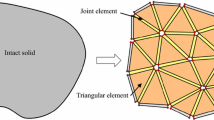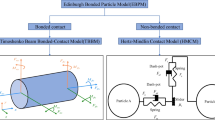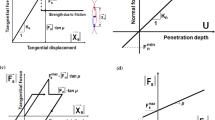Abstract
A three-dimensional model is presented and used to reproduce the laboratory hydraulic fracturing test performed on a thick-walled hollow cylinder limestone sample. This work aims to investigate the implications of the fluid flow on the behaviour of the micro-structure of the rock sample, including the material strength, its elastic constants and the initialisation and propagation of fractures. The replication of the laboratory test conditions has been performed based on the coupled Discrete Element Method (DEM) and Computational Fluid Dynamics scheme. The numerical results are in good agreement with the experimental data, both qualitatively and quantitatively. The developed model closely validates the overall behaviour of the laboratory sample, providing a realistic overview of the cracking propagation towards total collapse as well as complying with Lame’s theory for thick-walled cylinders. This research aims to provide some insight into designing an accurate DEM model of a fracturing rock that can be used to predict its geo-mechanical behaviour during Enhanced Oil Recovery applications.




















Similar content being viewed by others
References
Akram MS, Sharrock GB (2009) Physical and Numerical Investigation of a Cemented Granular Assembly under Uniaxial and Triaxial Compression. Paper presented at the 43rd US Rock Mechanics Symposium and 4th US-Canada Rock Mechanics Symposium, Asheville
Aminuddin NJPNIM (2011) Scatter-plot analysis of microcracks pattern behaviour of Weathered Limestone at Batu Caves, Malaysia. EJGE 16:1639–1650
Ayob AB, Tamin MN, Elbasheer MK (2009) Pressure limits of thick-walled cylinders. In: International MultiConference of Engineers and Computer Scientists 2009, Hong Kong, March 18–20
Bachu S, Bennion B (2008) Effects of in situ conditions on relative permeability characteristics of CO2-brine systems. Environ Geol 54(8):1707–1722. doi:10.1007/s00254-007-0946-9
Blunt M, Fayers FJ, Orr FM Jr (1993) Carbon dioxide in enhanced oil recovery. Energy Convers Manag 34(9–11):1197–1204. doi:10.1016/0196-8904(93)90069-m
Bouteca MJS, JP, Vincke O (2000) Constitutive law for permeability evolution of sandstones during depletion. Paper presented at the SPE International Symposium on Formation Damage Control, Louisiana
Boutt DF, Cook BK, McPherson BJOL, Williams JR (2007) Direct simulation of fluid-solid mechanics in porous media using the discrete element and lattice-Boltzmann methods. J Geophys Res Solid Earth 112(B10):B10209. doi:10.1029/2004JB003213
Bruno MS (1994) Micromechanics of stress-induced permeability anisotropy and damage in sedimentary rock. Mech Mater 18(1):31–48. doi:10.1016/0167-6636(94)90004-3
Bryant S, King P, Mellor D (1993) Network model evaluation of permeability and spatial correlation in a real random sphere packing. Transp Porous Med 11(1):53–70. doi:10.1007/bf00614635
Chang SC (1987) Micromechanical modelling of constitutive relations for granular materials. In: Jenkins JT, Satake M (eds) Micromechanics of granular materials. Elsevier, Amsterdam, pp 271–279
Chen S, Doolen GD (1998) Lattice Boltzmann method for fluid flows. Annu Rev Fluid Mech 30:329–364. doi:10.1146/annurev.fluid.30.1.329
Dong S (2007) Direct numerical simulation of turbulent Taylor–Couette flow. J Fluid Mech 587:373–393. doi:10.1017/S0022112007007367
Dullien FAL (1979) Porous media: fluid transport and pore structure, 2nd edn. Academic Press Inc, New York
Elkadi AS, van Mier JGM (2004) Scaled hollow-cylinder tests for studying size effect in fracture processes of concrete. In: Paper presented at the fracture mechanics of concrete structures, vol 1. USA, pp 229–236
Enever J, Bailin W (2001) Scale effects in hollow cylinder tests. In: Proceedings of the Asian Rock Mechanics Symposium; 209–212. A A Balkema, p 4
Eshiet KI, Sheng Y, Jianqiao Y (2013) Microscopic modelling of the hydraulic fracturing process. Environ Earth Sci 68(4):1169–1186. doi:10.1007/s12665-012-1818-5
Eslami JGD, Hoxha D (2010) Estimation of the damage of a porous limestone from continuous (P- and S-) wave velocity measurements under uniaxial loading and different hydrous conditions. Geophys J Int 183:1362–1375. doi:10.1111/j.1365-246X.2010.04801.x
Ewy RT, Cook GW, Myer LR (1988) Hollow cylinder tests for studying fracture around underground openings. Paper presented at the The 29th US Symposium on Rock Mechanics (USRMS), Minneapolis, MN, June 13–15
Ferfera FMR, Sarda JP, Boutéca M, Vincké O (1997) Experimental study of monophasic permeability changes under various stress paths. Int J Rock Mech Min Sci 34(3–4):126. doi:10.1016/S1365-1609(97)00105-6
Funatsu T, Ishikawa M, Shimizu N, Li Q, Seto M (2007) Study on the numerical modeling of crack propagation in rock by the distinct element method. Paper presented at the 11th Congress of the International Society for Rock Mechanics
Gil I, Roegiers JC, Hart R, Shimizu Y (2005) Modeling the Mechanical Properties of Antler Sandstone using a Discrete Element Model. Paper presented at the 40th Symposium on Rock Mechanics: Rock Mechanics for Energy, Mineral and Infrastructure Development in the Northern Regions, Anchorage, Alaska
Gordalla B, Ewers U, Frimmel F (2013) Hydraulic fracturing: a toxicological threat for groundwater and drinking-water? Environ Earth Sci 70(8):3875–3893. doi:10.1007/s12665-013-2672-9
Hallsworth CR, Knox RW O’ B (1999) British Geological Survey: Classification of sediments and sedimentary rocks. vol 3. Nottingham
Hanson ME, Anderson GD, Shaffer RJ (1980) Theoretical and experimental research on hydraulic fracturing. J Energy Resour Technol Trans ASME 102(2):92–98
Holt RM (1990) Permeability reduction induced by a non-hydrostatic stress field. SPE Form Eval 5(4):444–448. doi:10.2118/19595-PA
IEAGHG (2011b) Caprock Systems for Geological Storage. vol 01
IPCC (2007a) Climate Change 2007: “Synthesis Report”
IPCC (2007b) Technical Summary. IPCC WG1 AR4 Report
Itasca-Consulting-Group (2008a) Particle flow code in 3 dimensions (PFC3D). ICG, Minneapolis
Itasca-Consulting-Group (2008b) User’s Guide 1: Introduction. Minneapolis
Itasca-Consulting-Group (2008c) User’s Guide 3: PFC FishTank. Minneapolis
Jaeger JC, Cook NGW, Zimmerman RW (2009) Fundamentals of rock mechanics. Wiley-Blackwell, New York
Jia Y, Li Y, Hlavka D (2009) Flow through packed beds. University-of-Rochester, New York
Jin H, Gao L, Sheng L, Porter R et al (2012) Opportunities for early Carbon Capture Utilisation and Storage development in China. 13:13
Kissinger A, Helmig R, Ebigbo A, Class H, Lange T, Sauter M, Heitfeld M, Klünker J, Jahnke W (2013) Hydraulic fracturing in unconventional gas reservoirs: risks in the geological system, part 2. Environ Earth Sci 70(8):3855–3873. doi:10.1007/s12665-013-2578-6
Knill JL, Cratchley CR, Early KR, Gallois RW, Humphreys JD, Newbery J, Price DG, Thurrell RG (1970) The logging of rock cores for engineering purposes. vol 3. Geological Society Engineering Group Working Party Report
Lange T, Sauter M, Heitfeld M, Schetelig K, Brosig K, Jahnke W, Kissinger A, Helmig R, Ebigbo A, Class H (2013) Hydraulic fracturing in unconventional gas reservoirs: risks in the geological system part 1. Environ Earth Sci 70(8):3839–3853. doi:10.1007/s12665-013-2803-3
Li L, Holt RM (2001) Simulation of flow in sandstone with fluid coupled particle model. Paper presented at the Rock Mechanics in the National Interest, Elsworth
Martinez D (2012) Fundamental hydraulic fracturing concepts for poorly consolidated formations. University of Oklahoma, Norman
Mikkelsen M, Jorgensen M, Krebs FC (2010) The teraton challenge. A review of fixation and transformation of carbon dioxide. Energy Environ Sci 3(1):43–81
Moin P, Mahesh K (1998) Direct numerical simulation: a tool in turbulence research. Annu Rev Fluid Mech 30:539–578
Nield AD, Bejan A (2006) Convection in Porous Media, vol 3. Springer, Berlin
Olsson O, Weichgrebe D, Rosenwinkel K-H (2013) Hydraulic fracturing wastewater in Germany: composition, treatment, concerns. Environ Earth Sci 70(8):3895–3906. doi:10.1007/s12665-013-2535-4
Parker ME, Meyer JP, Meadows SR (2009) Carbon dioxide enhanced oil recovery injection operations technologies (Poster Presentation). Energy Procedia 1(1):3141–3148. doi:10.1016/j.egypro.2009.02.096
Perry J, Aboudi J (2003) Elasto-plastic stresses in thick walled cylinders. J Press Vessel Technol 125(3):248–252. doi:10.1115/1.1593078
Potyondy DO, Cundall PA (2004) A bonded-particle model for rock. Rock Mech Min Sci 41:1329–1364. doi:10.1016/j.ijrmms.2004.09.011
Riedl J, Rotter S, Faetsch S, Schmitt-Jansen M, Altenburger R (2013) Proposal for applying a component-based mixture approach for ecotoxicological assessment of fracturing fluids. Environ Earth Sci 70(8):3907–3920. doi:10.1007/s12665-013-2320-4
Tomiczek K (2003) Modeling of sandstone rock samples using PFC2D code. Paper presented at the Numerical Modeling in Micromechanics via Particle Methods, Lisse
Tsuji Y, Kawaguchi T, Tanaka T (1993) Discrete particle simulation of two-dimensional fluidized bed. Powder Technol 77(1):79–87. doi:10.1016/0032-5910(93)85010-7
University-of-Stanford Some Useful Numbers on the Engineering Properties of Materials. http://www.stanford.edu/~tyzhu/Documents/Some%20Useful%20Numbers.pdf. Accessed Sept 2013
University-of-Washington flow through packed beds. http://faculty.washington.edu/finlayso/Fluidized_Bed/FBR_Fluid_Mech/packed_beds_scroll.htm. Accessed Nov 2013
University-of-Washington Thick wall cylinders. http://courses.washington.edu/me354a/Thick%20Walled%20Cylinders.pdf. Accessed Nov 2013
Walton K (1987) The effective elastic moduli of a random packing of spheres. J Mech Phys Solids 35(2):213–226. doi:10.1016/0022-5096(87)90036-6
Wilkins SJ, Naruk SJ (2007) Quantitative analysis of slip-induced dilation with application to fault seal. AAPG Bull 91(1):97–113. doi:10.1306/08010605177
Wright PJF (1955) Comments on an indirect tensile test in concrete cylinders. Magazine of Concrete Research 7 (20):87–96
Xu BH, Yu AB (1997) Numerical simulation of the gas-solid flow in a fluidized bed by combining discrete particle method with computational fluid dynamics. Chem Eng Sci 52(16):2785–2809. doi:10.1016/S0009-2509(97)00081-X
Zhang X, Last N, Powrie W, Harkness R (1999) Numerical modelling of wellbore behaviour in fractured rock masses. J Pet Sci Eng 23(2):95–115. doi:10.1016/S0920-4105(99)00010-8
Ziqiong Z (1989) NGWC stress induced microcrack geometry at failure in unconfined and confined axial compressive tests. In: 30th US symposium on rock mechanics (USRMS), Morgantown, WV. American Rock Mechanics Association (ARMA)
Acknowledgments
The authors would like to thank the School of Civil Engineering and the Energy Technology and Innovation Initiative (ETII) of the School of Process, Environmental and Materials Engineering, University of Leeds for sponsoring this research. The authors also appreciate the provision of experimental facilities by the Wolfson Multiphase Flow Laboratory of the School of Earth and Environment, University of Leeds.
Author information
Authors and Affiliations
Corresponding author
Rights and permissions
About this article
Cite this article
Marina, S., Imo-Imo, E.K., Derek, I. et al. Modelling of hydraulic fracturing process by coupled discrete element and fluid dynamic methods. Environ Earth Sci 72, 3383–3399 (2014). https://doi.org/10.1007/s12665-014-3244-3
Received:
Accepted:
Published:
Issue Date:
DOI: https://doi.org/10.1007/s12665-014-3244-3




